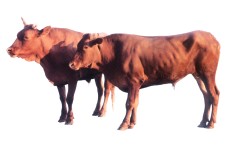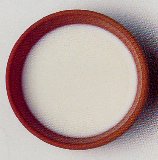Milk, Cow
http://www.100md.com
《e Natural Health Center》
 |
 |
 |
Eggs, Milk
Milk, Cow
Latin:
Origin:
Cow milk (bovine species) is by far the principal type of mammal milk used by humans since the beginning of recorded time to provide both fresh and storable nutritious foods throughout the world.
In some countries almost half the cow milk produced is consumed as fresh pasteurized whole, low-fat, or skim milk. However, most milk is manufactured into more stable dairy products of worldwide commerce, such as butter, cheese, dried milks, ice cream, and condensed milk.
, 百拇医药
In the early 1800s the average dairy cow produced less than 1,500 litres of milk annually. With advances in animal nutrition and selective breeding, one cow now produces an average of 6,500 litres of milk a year, with some cows producing up to 10,000 litres.
The Holstein-Friesian cow produces the greatest volume, but other breeds such as Ayrshire, Brown Swiss, Guernsey, and Jersey, while producing less milk, are known for supplying milk that contains higher fat, protein, and total solids.
, 百拇医药
Properties:
Sweet in flavor, mild in nature, it is related to the channels of the heart, spleen, lung and stomach.
Functions:
Treats consumptive disease, reinforces the lung and stomach, promotes the production of body fluid and moistens the intestinal tract.
Applications:
, http://www.100md.com Cow's milk is used to treat debility and internal injury caused by over-strain, regurgitation, dysphagia (difficulty in swallowing), diabetes and constipation.
Cow's milk is often prescribed in Chinese medicine for a weak constitution and for those who need building up.
Dosage and Administration:
To be taken after boiling or sterilization. Milk, a ubiquitous cooking and baking ingredient, is often enjoyed straight from the glass or over cereal.
, 百拇医药
Refrigerate milk, and use it within two to seven days. Store powdered milk in a cool, dry cupboard; it will keep for several weeks after the package is opened.
Cautions on Use:
Precaution should be taken by patients suffering from diarrhea caused by insufficiency of the spleen-yang or fluid-retention or phlegm-dampness in the body.
Some people cannot digest lactose, the sugar in milk. A rarer complaint is an allergy to the protein in milk. People with either condition should exclude milk and milk products from their diet.
, 百拇医药
Reference Materials:
Toxic or Side Effects:
Modern Researches:
Although milk is a liquid and most often considered a drink, it contains between 12 and 13 percent total solids and perhaps should be regarded as a food. In contrast, many "solid" foods, such as tomatoes, carrots, and lettuce, contain as little as 6 percent solids.
, http://www.100md.com
Many factors influence the composition of milk, including breed, genetic constitution of the individual cow, age of the cow, stage of lactation, interval between milkings, and certain disease conditions. Since the last milk drawn at each milking is richest in fat, the completeness of milking also influences a sample.
In general, the type of feed only slightly affects the composition of milk, but feed of poor quality or insufficient quantity causes both a low yield and a low percentage of total solids. Current feeding programs utilize computer technology to achieve the greatest efficiency from each animal.
, http://www.100md.com
The composition of milk varies among mammals, primarily to meet growth rates of the individual species. The proteins contained within the mother's milk are the major components contributing to the growth rate of the young animals. Human milk is relatively low in both proteins and minerals compared with that of cows and goats.
The major components of milk are water, fat, protein (mainly casein, albumin and globulin), carbohydrate (lactose), and minerals (ash). However, there are numerous other highly important micronutrients such as vitamins A, B1, B2, B6, C, essential amino acids, and trace minerals. Indeed, more than 250 chemical compounds have been identified in milk.
, http://www.100md.com
Vitamins B1 and B2, pantothenic acid and niacin, minerals phosphorus and magnesium that contained in milk play a role in releasing energy from food and producing enzymes that utilize the energy in food.
The fat in milk is secreted by specialized cells in the mammary glands of mammals. It is released as tiny fat globules or droplets, which are stabilized by a phospholipid and protein coat derived from the plasma membrane of the secreting cell.
, 百拇医药
Milk fat is composed mainly of triglycerides--three fatty acid chains attached to a single molecule of glycerol. It contains 65 percent saturated, 32 percent monounsaturated, and 3 percent polyunsaturated fatty acids. The fat droplets carry most of the cholesterol and vitamin A.
Therefore, skim milk, which has more than 99.5 percent of the milk fat removed, is significantly lower in cholesterol than whole milk (2 milligrams per 100 grams of milk, compared with 14 milligrams for whole milk) and must be fortified with vitamin A.
, http://www.100md.com
There is increasing evidence that an adequate intake of calcium during early life is necessary for the development of maximum bone mass at maturity (between the ages of 30 and 40). The better the bone mass that people have at maturity, the less likely they are to have bone fractures in old age. Milk supplies an easily absorbable form of calcium and, if drunk daily in early life, may reduce the risk of osteoporosis (a condition that affects especially older women and is characterized by decrease in bone mass with decreased density and enlargement of bone spaces producing porosity and fragility) in old age.
, 百拇医药
If insufficient calcium is deposited on growing bones in childhood, the bones may become weak, leading to rickets. The bowing of leg bones beneath the weight of a child is a symptom. Rickets is caused by a lack of viatmin D, which is needed by the body to absorb calcium from the intestines. Whole milk supplies this vitamin, and is very useful for children who do not have enough exposure to the sun. Without sunlight to make vitamin D, they have to rely on dietary sources.
, 百拇医药
Researchers have noticed that there is a lower risk of colonic cancer in populations in which people consume large amounts of calcium. It is thought that the calcium may combine with bile acids and prevent them from promoting cancerous cells in the colon. It is possible that a regular intake of milk could help to prevent other cancers too. Milk contains a fatty acid called conjugated linoleic acid, or CLA. Studies in the laboratory have shown that CLA reduces the incidence of some cancers by up to 50 percent. CLA may also boost the immune system and slow the development of diseases such as atherosclerosis (characterized by atheromatous deposits in and fibrosis of the inner layer of the arteries), which affect the artery walls, particularly in later life.
, http://www.100md.com
Low intakes of calcium may contribute to high blood pressure. Studies show that when people took calcium supplements their blood pressure dropped.
Those who cannot tolerate lactose (milk sugar), or vegetarians who reject all dairy products, must find their calcium from other food sources, such as vegetables, beans and nuts. The calcium from these foods is absorbed less efficiently than it is from milk.
Protein is necessary for the general growth, maintenance and repair of body tissue. Dairy products such as milk and cheese contain all the essential amino acids, so they are good sources of high-biological-value protein., 百拇医药